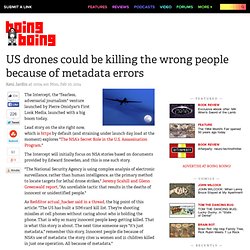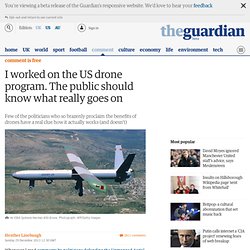Drones + Robots + Tech
> Benjaminbacon
Start [ PIRATEBOX]
Here’s What Happens When You Strap An Oculus-Controlled Video Camera To A Drone And Take It For A Spin. Crystal forming robots. Christian Faubel, Crystal forming robots on overhead The Crystal Forming Robots are little autonomous robots that are placed on an overhead projector.

Each robot is powered by the light of the projector and their movements over its surface make tangible the growth process of crystal structures. When a robot has collected enough energy, it will start moving around.
Virtual Spaces, Real Data, Why Oculus and Facebook Are Bad. It Takes a Village to Build a Free, Open Source, 3D-Printed Robot. Quickly Prototype Circuits With New Inkjet-Printable Conductive Ink.
Zuck Nerds Out On Drones Vs. Satellites For Delivering Internet. Free Space Optic lasers? Low earth orbit satellites? Solar-powered drones? Mark Zuckerberg has just penned a deep dive on how Facebook’s newly revealed methods for delivering Internet to the developing world actually work. Here’s are the highlights from his 3000 word progress report on Internet.org, including digs at Google’s Project Loon, and how it all fits into Facebook’s long-term plan. First, the “Why”. Until now, Internet.org (a partnership between Facebook and six telecom giants) has been using partnerships to expand Internet access.
DARPA wants drones that work like Ender’s Game (the movie)
On April 11, the Defense Advanced Research Projects Agency (DARPA) will kick off an effort to make the Defense Department’s existing unmanned systems act more like squadrons of manned aircraft.

The New Rules of Robot/Human Society. Team Designs Tiny Robots That Can Build Like Termites. The Gun That Aims Itself (Documentary)
The Restart Page - Free unlimited rebooting experience from vintage operating systems. US drones could be killing the wrong people because of metadata errors. The Intercept, the "fearless, adversarial journalism" venture launched by Pierre Omidyar's First Look Media, launched with a big boom today.

Lead story on the site right now, which is https by default (and straining under launch day load at the moment) explores "The NSA’s Secret Role in the U.S. Assassination Program.
" The Intercept will initially focus on NSA stories based on documents provided by Edward Snowden, and this is one such story. "The National Security Agency is using complex analysis of electronic surveillance, rather than human intelligence, as the primary method to locate targets for lethal drone strikes," Jeremy Scahill and Glenn Greenwald report, "An unreliable tactic that results in the deaths of innocent or unidentified people.
"
Roboterträume Pressebilder. The NSA's Secret Role in the U.S. Assassination Program. Credit: Kirsty Wigglesworth/Associated Press.

The National Security Agency is using complex analysis of electronic surveillance, rather than human intelligence, as the primary method to locate targets for lethal drone strikes – an unreliable tactic that results in the deaths of innocent or unidentified people. According to a former drone operator for the military’s Joint Special Operations Command (JSOC) who also worked with the NSA, the agency often identifies targets based on controversial metadata analysis and cell-phone tracking technologies. Rather than confirming a target’s identity with operatives or informants on the ground, the CIA or the U.S. military then orders a strike based on the activity and location of the mobile phone a person is believed to be using. His account is bolstered by top-secret NSA documents previously provided by whistleblower Edward Snowden.
Programming molecular robots.
A Q&A with Wyss Core Faculty members William Shih and Peng Yin In the late 1990s, a small group of bioengineers set out to turn cells into tiny robots.

Being bioengineers, they drew ideas from engineering, and envisioned building a set of modular, standard parts akin to the sensors, power source, microprocessor and actuators that enable robots to sense and respond to their surroundings. Those early efforts spurred a wave of optimism about the incredible potential of synthetic biology. But getting even simple organisms to carry out the right tasks at the right time remains a formidable task, and synthetic biologists are still a long way from making living cells obey their commands.
Google introduces smart contact lens project to measure glucose levels. It's not April 1.

It's still 2014. This isn't a joke. Google just introduced a smart contact lens. For now it's only a Google[x] experiment, but the idea involves a contact lens with a small wireless chip and a sensor that can measure a diabetic's glucose levels. For someone with diabetes, glucose levels require constant monitoring, usually by pricking the end of the finger and putting a drop of blood into a glucose measuring device.
Scientists create winged-jellyfish drone…and it's beautiful. Drones now have six American “test ranges” in which to fly. In November 2013, the Federal Aviation Administration (FAA) published its “roadmap” for integrating drones (or, if you prefer the government’s term, "unmanned aircraft systems") into American skies.

Part of that document included selecting six drone “research and test” sites across the country. On Monday, the FAA announced its nationwide picks for the six site operators. As the FAA wrote: In selecting the six test site operators, the FAA considered geography, climate, location of ground infrastructure, research needs, airspace use, safety, aviation experience, and risk. In totality, these six test applications achieve cross-country geographic and climatic diversity and help the FAA meet its UAS research needs.
I worked on the US drone program. The public should know what really goes on. Whenever I read comments by politicians defending the Unmanned Aerial Vehicle Predator and Reaper program – aka drones – I wish I could ask them a few questions.

I'd start with: "How many women and children have you seen incinerated by a Hellfire missile?
" And: "How many men have you seen crawl across a field, trying to make it to the nearest compound for help while bleeding out from severed legs?
"
Steered by thoughts, drone flies through hoops - tech - 05 June 2013.
If you hate red-light cameras, you’ll really hate speeding ticket robots. STANFORD, CA—Four academics from West Point and Samford University in Alabama set out to answer a seemingly simple question: how would one write a computer program to issue speeding tickets?

After all, speed limits are fairly simple—you’re either driving faster than the posted number or you’re not. In the age of Google and its competitors making fully autonomous cars (and states passing laws to allow them), it’s not hard to imagine fully autonomous law enforcement for traffic violations, either. After all, we already have red-light cameras. “If anyone thinks it is a simple thing to do, to take a simple law [and convert it to machine-readable code], it is significantly more complicated than one thought,” Woodrow Hartzog, a law professor at the Cumberland School of Law at Samford University and one of the paper's co-authors, told Ars. Hartzog and one of his co-authors presented a paper (PDF) at the “We Robots” conference at Stanford Law School on Monday.
Robot Ants Could Make Us More Efficient. With their tiny wires and circuits, robotic ants won’t be taking over the world anytime soon.

But what these artificial insects lack in processing power, they make up for in efficiency: Robotic ants can automatically choose the shortest route from their food sources back to their nests, just like real ants, a new study says. This gives valuable insight into how people should plan transportation and communication systems. “It’s really interesting to look at social insects because [they] can give us a way to manage information in our societies,” said Guy Theraulaz, a behavioral biologist at the National Center for Scientific Research in France, a co-author on the study.
“We take some inspiration from nature.” (Related: “Color-Changing Rubber Robot Could Aid Animal Study.”)
What Can Drones Do Without Humans? — NOVA Next. For many, the word “drone” summons images of innocent civilians killed in wars conducted from thousands of miles away and raises concerns about invasions of privacy. For others, a drone is simply a next-generation military weapon that saves both lives and money. And for still others, drones are a fascinating backyard hobby for adults and children alike.
Fearsome UK Robot Aircraft Is Semi-Autonomous and Will Fly in 2013. Rise of the Drones. Rise of the Drones PBS Airdate: January 23, 2013. Watch These Quadcopters Flip A Reverse Pendulum Into The Air And Catch It (No, Seriously, Watch)
Drone ‘Nightmare Scenario’ Now Has A Name: ARGUS. msnbcmedia.msn.com/i/msnbc/sections/news/020413_DOJ_White_Paper.pdf. The Veil of Secrecy is Lifting on Drones. Here's What You Need to Know.
With Brennan Pick, a Light on Drone Strikes’ Hazards.










